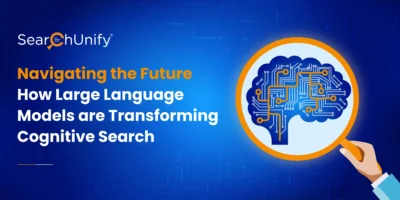
In the vast expanse of information that defines our digital age, traditional enterprise search methods often stumble upon a critical challenge: unraveling the intricate relationships and underlying context that tie together documents and data.
The limitations of these conventional approaches become increasingly apparent as the data grows, resulting in imprecise results due to mediocre information retrieval. Enter vector search, an innovative paradigm poised to reshape the enterprise search landscape as we know it.
Imagine a solution that not only addresses the shortcomings of traditional methods but does so with unprecedented finesse, understanding the essence of queries on a deeper level. Vector search does that and more; it harnesses the power of mathematical vectors to encode documents within a high-dimensional space, where proximity becomes synonymous with similarity.
In this blog post, we embark on a journey to understand how vector search works and what it means for businesses.
What is Vector Search?
As mentioned earlier, vector search leverages mathematical representations of data (vectors) to transform the way we search and retrieve information. It captures complex relationships and semantic nuances between items to deliver accurate and contextual results. Its significance reverberates across diverse applications such as:
- Revolutionizing enterprise search systems by delivering more precise results
- Empowering image retrieval systems to identify similar visuals with unprecedented accuracy
- Refining the capabilities of natural language processing models to comprehend context and meaning in textual data like never before
Now that we have a fair idea of what vector search is, let’s understand how it works.
How Vector Search Works
At the heart of vector search lies the transformation of data points into vectors within high-dimensional spaces. This process involves encoding the characteristics and attributes of each data point as a vector, enabling the capture of intricate relationships and nuances.
One of the key advantages here is the preservation of semantics and context. Unlike conventional methods that treat data points as isolated entities, vector representations maintain the relationships between items, facilitating more accurate and contextually relevant searches. This transformation allows vector search to excel in tasks that require understanding similarities, analogies, and hierarchies among data points.
But all said and done, vector search doesn’t just rely on this transformation; it leverages a plethora of techniques that promise relevant outcomes. They include:
- Cosine Similarity: Central to vector search is the concept of cosine similarity. This metric quantifies the similarity between two vectors based on the cosine of the angle between them. A smaller angle implies higher similarity. Cosine similarity captures the directionality of vectors, disregarding their magnitudes, making it particularly useful for measuring semantic similarity.
- Euclidean Distance: In contrast to cosine similarity, Euclidean distance measures the spatial separation between vectors. It’s a straightforward metric that considers both direction and magnitude. While cosine similarity works well for capturing semantic relationships, Euclidean distance shines in scenarios where vector magnitudes hold significance.
- Approximate Nearest Neighbor (ANN) Algorithms: Efficiently handling massive datasets requires advanced techniques. ANN algorithms like k-d trees, ball trees, and locality-sensitive hashing (LSH) strike a balance between accuracy and efficiency. They partition the vector space into hierarchical structures, enabling faster searches by eliminating irrelevant portions of the space.
- Neural Network-based Approaches: Modern vector search engines leverage neural networks for end-to-end learning of meaningful representations. Siamese networks and triplet networks are particularly relevant. Siamese networks learn to distinguish between similar and dissimilar pairs of vectors, while triplet networks optimize the arrangement of anchor, positive, and negative vectors. These networks adapt to the unique intricacies of data, significantly improving similarity tasks.
A Glimpse into Applications of Vector Search
The power of vector search extends far beyond theory, finding its mettle in a multitude of real-world applications. Let’s explore some compelling use cases where vector search shines as a guiding light, illuminating the path to enhanced understanding and discovery.
- Semantic Search: Semantic search, often dubbed the “holy grail” of information retrieval, hinges on understanding context and meaning within a user’s query. Here, vector search recognizes the intricate connections between words and concepts. Whether it’s dissecting the nuanced semantics in a text or deciphering the underlying themes in a document, vector search leaps beyond mere keyword matching. The result? Search outcomes that are not just relevant but contextually rich, empowering users with insights that align seamlessly with their intent.
- Personalized Recommendations: In the realm of recommendations, vector search emerges as a silent orchestrator, tailoring suggestions with an artful touch. By mapping user preferences and item attributes into the same vector space, vector search identifies the latent affinities between them. This intricate dance of vectors allows for a personalized journey, be it e-commerce, content platforms, or entertainment. Whether it’s suggesting the perfect book or surfacing the next binge-worthy show, vector search bridges the gap between user preferences and relevant offerings, enhancing user experiences across the digital spectrum.
- Question Answering: Question-answering systems, fueled by vector search, transform the way we interact with data. Imagine posing a query and receiving not just a list of potential answers but a ranked selection that captures the essence of your question. Vector search engines decipher the nuances of the inquiry, transforming it into a vector that traverses landscapes of knowledge. This journey through the vector space leads to the discovery of documents, paragraphs, or even sentences that hold the answers. The result? A more efficient and intuitive approach to gaining insights from vast reservoirs of information.
So, it’s safe to say that vector search engines are a worthy addition. But how do you choose one? Let’s find out!
Selecting the Right Vector Search
In the ever-evolving landscape of technology, choosing the ideal vector search engine demands a strategic approach tailored to your unique circumstances. Here’s a compass for navigating the considerations that will guide your decision-making process:
- Current Search Solution: Your starting point is crucial. Does your existing enterprise search engine support vector search? If not, can it be added? This could determine whether you embark on a transformation within your current framework or explore a new search solution.
- Integration and Adaptation: Are you looking for a complementary add-on to your current search setup? Or do you envision an entirely new paradigm? The scalability and adaptability of the chosen vector search engine should align seamlessly with your aspirations.
- In-house vs. External Hosting: Consider your resources and capabilities. Can you manage the complexities of hosting and maintaining intricate technologies in-house, or would an externally hosted solution be more viable? The decision hinges on the optimal alignment of technical expertise and infrastructure.
- Skills and Expertise: A vector search engine’s effectiveness relies on the expertise behind it. Do you have, or can you acquire, the necessary skills in machine learning and data science? The availability of these talents shapes the extent to which you can harness the potential of vector search.
- Investment and Innovation: Delve into your appetite for innovation. Are you open to investing in cutting-edge technologies, perhaps from emerging startups? Or do you lean towards established players with a track record? The decision here mirrors your readiness to explore new horizons or embrace established foundations.
Conclusion
As we venture further into a landscape saturated with data, vector search stands as a beacon of insight, revolutionizing how we navigate and glean value from the vast sea of information. Its vast applications underscore its significance in shaping the future of technology.
So, it won’t be wrong to say that vector search will remain a steadfast ally, equipping enterprises with the tools to uncover hidden patterns, drive innovation, and uncover the true potential within our data-rich world. In a not-so-distant post, we will be covering the nuances of vector search in the era of large language models. Stay tuned for that one.


















